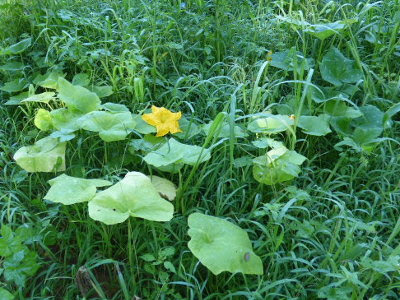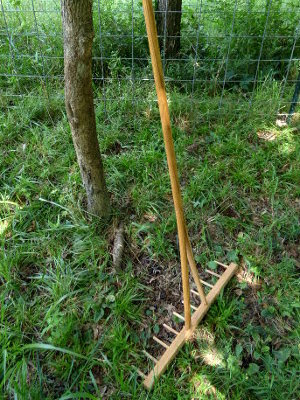The paddock was thick with lush grass. The only thing was, that's not what I planted. What I planted was grain sorghum, cushaws, amaranth, black turtle beans, and a living mulch of ladino clover. But all we could see was grass; completely engulfing everything else, except some of the cushaws, which have managed to send out quite a few sprawling vines over the top. So much for weed control.
It looked really good though, and we wondered what it was. In looking through a website about native grasses, my best guess is Florida paspalum. I would have liked to turn the goats into it, except I didn't want them eating the few planted plants that actually made it. What else to do but cut it for hay.
Dan has both high-tech and low-tech tools for haying: a sickle mower and a scythe. This would be a good job for the sickle mower, but it's on the fritz (again) and at a point where replacement parts can't be found. That's the bad thing about buying older used equipment. Fortunately he still has the scythe.
Actually, he has two scythes. The first he bought is an American scythe (shown in this blog post, "New hand Tools"). The one he prefers is pictured above, a European scythe (which I thought I had blogged about but apparently not because I can't find a post about it.) He prefers it for several reasons.
I don't know who manufacturers American scythes, but they are all the same size and have fixed hand grips. Unfortunately, that size is only appropriate for a very short person. Anyone taller has to stoop to use it. That's tiring! Comfortable scything is done with a straight back. The rhythmic swinging movement is in the hips. Because people are different sizes, there is no one-size-fits-all tool for the job. That means the American scythe is only going to be useful for a limited number of folks.
European scythes are ordered according to one's height. The snath (wooden part) is straighter, lighter weight, and has hand grips that are adjustable. All of that makes it comfortable to use.
Unlike the American scythe, a variety of blades are available for European scythes. Dan has been slowly acquiring different blades and finds it's very helpful to have a choice depending on vegetation and terrain.
The other tool we've found extremely useful for haying is a hay rake.
Ours is wood but nylon hay rakes are also available. We used to use a garden rake, but the hard tines continually got caught in the underlying uncut vegetation. A proper hay rake makes the job of turning and raking up so much easier!
Dan tried to work around the cushaw vines and discovered one squash.
My black turtle beans were completely engulfed and didn't do well, but I managed to find a small harvest of dried bean pods. He left the grain sorghum too, which hasn't done well either. It looks pretty spindly and I suspect it's getting too much shade.
However, if I can at least get a seed crop out of it and the black turtle beans for next year, then I'll feel like I at least broke even. Ditto for the amaranth.
The funny thing is that Dan had recently suggested that we use this paddock for growing our hay next year. It appears nature got a jump start on that one.
The grass was thick and took several days of turning to dry it. It dried more brown than green, but had a very nice scent. Once dry, we raked it up and carted if off to the barn. That evening the goats all got a sample. Approved!
Native grasses tend to be regional. If you are interested in identifying some of your own native grasses, head on over to this article at On Pasture online magazine. It has links to good resources for identifying those native grasses by your region.
Unexpected Hay Harvest © August 2018 by








16 comments:
I don't do any serious mowing with a scythe anymore, but I sold my weed-whacker and went back to the scythe for trim work. It's quiet, always starts, and produces no fumes.
Exactly!
Love the sythe and rake. Might contact your county extension service about identifying the grass. They can be a great resource.
We always had a scythe (and probably still do) back on the farm for those area where a tractor and mower can't get too and it is too much work to go start the weed wacker for such a small area. It isn't much but enough to appreciate how much work went into Dan doing your entire paddock!
I never considered getting the wrong seed for pasture grass. If the goats didn't like it what would you do with all of it?
Do you have to plow under all of the paddock and replant?
Lady Locust, good idea about the county cooperative extension service. I'll have to check their website too.
Ed, a scythe is a very handy tool. Very pleasant work once you get the knack.
Mike, well, it just volunteered! If it was something the goats didn't like, we would just cut it and let it decay back into the soil.
Excellent example of making lemonade out of lemons. Well done.
How often will you hay to get what you need for the winter? Will you get multiple cuttings from this native surprise ? I have often imagined what it would be like to farm somewhere that supplemental water would not be needed. Heck in most of California one can't even garden without some form of daily watering.
Thanks for the link. Will be fun to see what I find out. Good post and good work!
People in America are taller than they used to be. I recently saw people scything on t.v. and it was amazing...europe for sure. You are so right they use a hip motion and go quite quickly once they get the rhythm....it was a group side by side doing an entire field as they didn't have automated equipment....saves our atmosphere too! It's still hard work out in the hot sun though. Bless your husband and you both for working so hard. You're an inspiration! But I just cannot stand the heat anymore. It never used to bother me and I could work outside all day but maybe it's true that the older you get the 'extremes' of temperature bother you more? Stay cool and hydrated and get out early! LOL!
Well Leigh that link is a gem.
I read most of the way through and what a treat!
This morning as the Pyrs and walked the back 21 I was seeing it with new eyes. Some of what was out there I was aware of. But I found half a dozen new natives today. Now to goat test 😂
We recently bought a scythe from Lehman's. It must be a European style since we did have to choose a length and the hand grips can be moved. All the wooden parts came unfinished. Do you have a preferred finish for tools like this? My husband is thinking varnish but it's not too late if you have other advice. Thanks!
TB, exactly! Except it's making hay out of weeds. :)
Goatldi, I'm not really sure how much we'll need to get a full winter's supply. We planted more hay this year, but some of it hasn't done as well as we'd hoped, maybe too much rain. I'm tempted to buy hay now anyway, while there is something half-way decent available. The hay around here is generally very poor quality, i.e. people aren't really growing hay, they're just baling neglected fields. Waiting to see if the paspalum grows back. I hope so! In one of those PDFs I found at that link it said several cuttings can be had, which would be great. I'm glad you liked the link! Really useful, no matter what part of the country one lives in.
Sam, that's very true about height! We've visited a number of Civil War museums and it's amazing how small the uniforms are. Looks like they'd only fit a young teenager today. I'm guessing that the reproducer of those scythes either didn't understand the mechanics of scything, or is just making replicas as decorative items. We see a lot of old tools for sale as "yard art." As far as the heat, I have to say that one of the benefits of living without air conditioning is being better acclimated to it. Yes, it still feels hot and we drink lots of water, but it isn't such a shock to the system as when coming outdoors after being in AC.
Ann, after I read your comment I immediately had to go to Lehman's website to see! Yes, theirs looks like a European type (I've also seen them called Austrian scythes.) Dan prefers linseed oil as a finish for the snath. He says the problem with varnish is that it wears off unevenly and so isn't the best protection for the wood. For some really excellent scything videos, check out One Scythe Revolution. Botan also sells a nice variety of scythe blades (and the hay rake).
I'm glad the goats approved. It's gratifying when there is a good haycrop. I have quite a bit of hayland, but the guy who was cutting and baling it decided to plough it up this spring and has done nothing since, except disking part of it. It hasn't been seeded and is now full of weeds. Unfortunately I don't own the equipment to get this all done myself. I bought some red clover seed and am thinking I will at least seed the part that's been disked, but I'll need to broadcast it by hand. Well, live and learn. Thanks for the post.
My husband likes using his European scythe too, on the tall grass. Such a cool tool!
Phil, that's a real shame about the hay field. As we all learn the hard way, any bare ground is at nature's choice. I do a lot of broadcasting by hand and although it isn't the best method, it works. Red clover would be a good option for you.
M.K., yes, it works best on the long grasses! Really need our sickle mower working for the shorter stuff.
Post a Comment